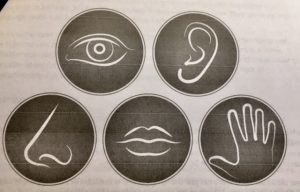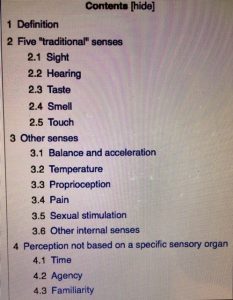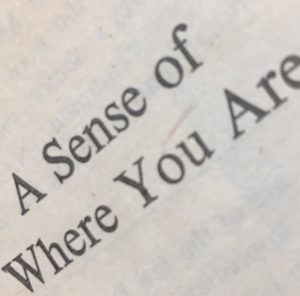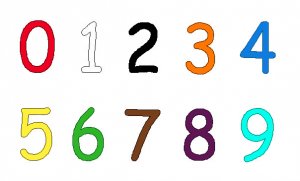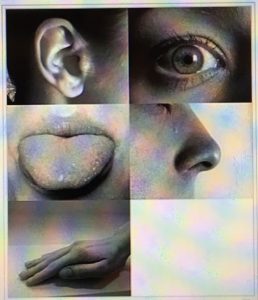When writers write human sensations, they typically rely on the basic five: sight (vision), hearing (audition), taste (gustation), smell (olfaction), and touch (somatosensation). Everyone since Aristotle has recognized these. But relying on these is over-simplification.
In fact, humans have a multitude of sensors. The ability to detect other stimuli beyond those governed by these most broadly recognized senses also exists, and these sensory modalities include temperature (thermoception), kinesthetic sense (proprioception), pain (nociception), balance (equilibrioception), vibration (mechanoreception), and various internal stimuli (e.g. the different chemoreceptors for detecting salt and carbon dioxideconcentrations in the blood, or sense of hunger and sense of thirst).
What constitutes a sense is a matter of debate, leading to difficulties in defining what exactly a distinct sense is, and where the borders lie between responses to related stimuli. Today, a conservative list of senses numbers 10 and the generally accepted list includes 21. The radical list identifies at least 33.
But as writers, we don’t have to worry about exact numbers and labels. We just need to develop a keener body awareness for our characters.
One of my personal favorites is proprioception, the sense that gives you the ability to tell where your body parts are in relation to other body parts and the environment. Being able to close your eyes and touch your nose is one example—a skill that is impaired when drunk, BTW.
I first really though about this sense when I read what John McPhee said about Bill Bradley, back in the day when Bill Bradley was a basketball superstar. McPhee was particularly impressed that Bradley, back to the basket, could look him in the eye, hold a conversation, and toss a basketball over his shoulder and make the shot.
Bradley: “When you have played basketball for a while, you don’t need to look at the basket when you are in close like this….You develop a sense of where you are.”
Any character who is athletic would have a highly developed sense of body awareness. The opposite of Bill Bradley is the character who is forever bumping her/his head, tripping, knocking into things, etc.
Choose any sense and have a character who is characterized by an extreme of that sense. For example, tea, wine, or coffee tasters; acrobats; inability to feel pain or temperature; etc.
Numerous studies have shown that people do have the ability to detect accurately the passage of time, without counting or anything like that: on average, 18 to 24 year olds could tell when 3 minutes were up within a 3 second margin. And perhaps more interesting, our sense of time slows down with age, so that 60-80 year olds, on average, thought that 3 minutes had passed at around 3 minutes and 40 seconds! Again, this might be more useful for people on either extreme from the average. FYI, people with Parkinson’s or ADD have very poor sense of time passage compared to “normal” people.
Synesthesia is, essentially, when our sensory wires get crossed. Such people hear or taste color, for example. Although some people experience this naturally, it is more common under the influence of hallucinogens.
BOTTOM LINE: Do a little reading online about human senses to develop awareness of how these can enhance your writing!

